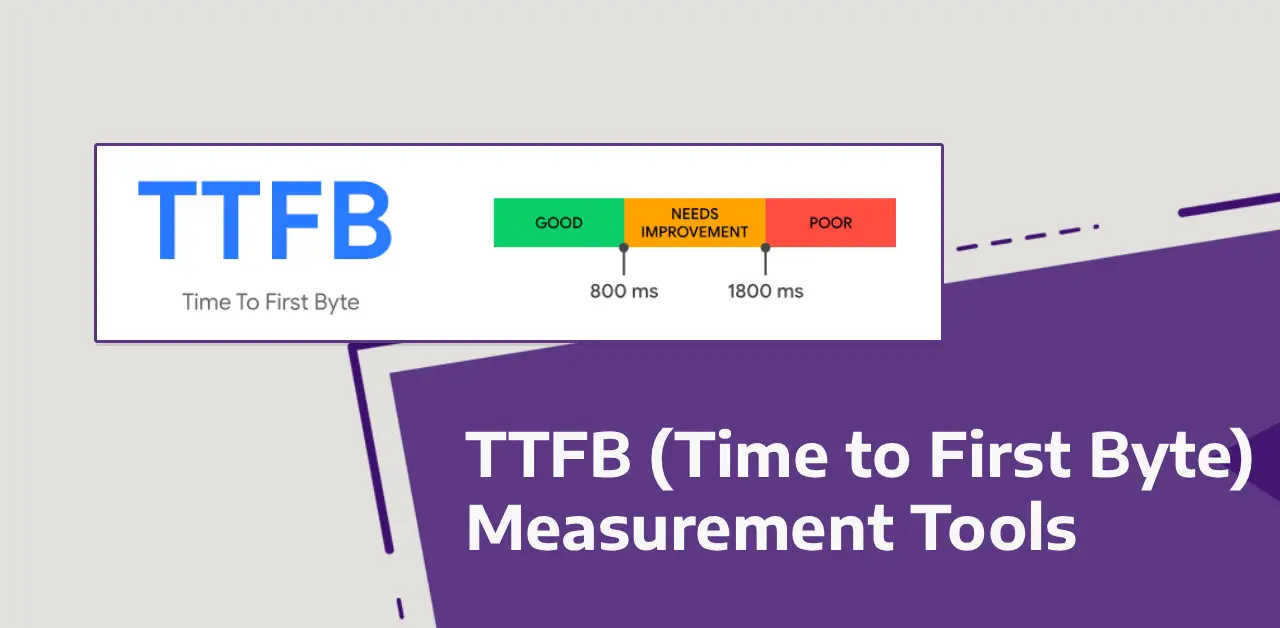TTFB is the time to first byte, which indicates the amount of time that it takes the browser to receive the first byte of data from the server within a request.
TTFB is a critical aspect to consider when analyzing a website’s speed. And, let’s be honest, it is the leading cause of slow performance for the majority of websites.
You can test anything on the web, like a webpage, an image file, a font, or CSS. You can measure the response time of your origin server or CDN provider. Moreover, the time to first byte can be tested separately for mobile devices and PCs.
Plus, you’ll get an optimistic user experience if your time to first byte is low, since your page will load instantly, assuming everything is okay.
But if it is too high, the user will see a blank screen for a short period until the server responds. It’s a significant factor in Web Vitals scores. And according to Google, good TTFB values are under 0.8 seconds, and negative values are over 1.8 seconds:

A longer distance between your server and visitors results in increased latency and slower TTFB. That’s why professionals recommend CDNs for optimization.
It also significantly affects other core web metrics. TTFB plays a big part in this process, which is why it’s critical. Now, we are going to explore some practical measuring tools (websites) for checking the time to first byte of your website.
KeyCDN Performance Test

KeyCDN is a famous European CDN provider with over 60 distribution points. It isn’t my favorite, but I like their website performance measurement tools.
There are several measurement tools available which can be used to troubleshoot website, network, and CDN issues.
With “Performance Test,” you can test a website’s time to first byte from 10 different locations around the world. It has a simple UI and allows you to test and measure any URL. You’ll get a breakdown of loading times and HTTP headers in the results.
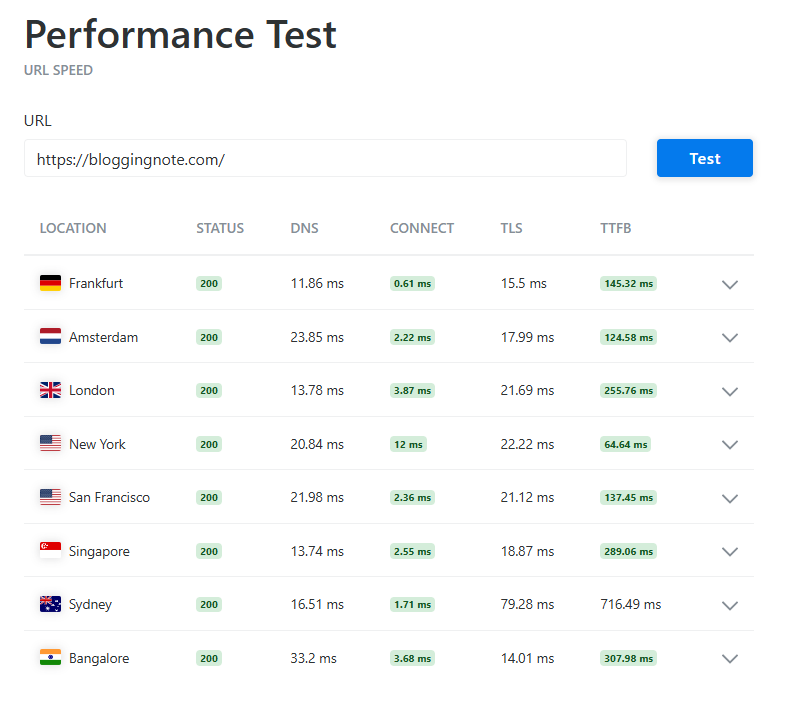
Aside from TTFB, you can also view location, status codes, DNS lookup time, connection time, and TLS overhead.
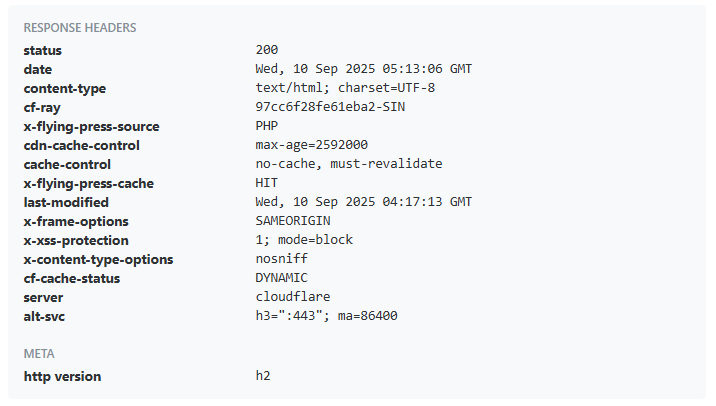
The HTTP header status includes additional data such as cache status, CDN details, modified date, cache control, HTTP version, content type, and others.
Flying TTFB
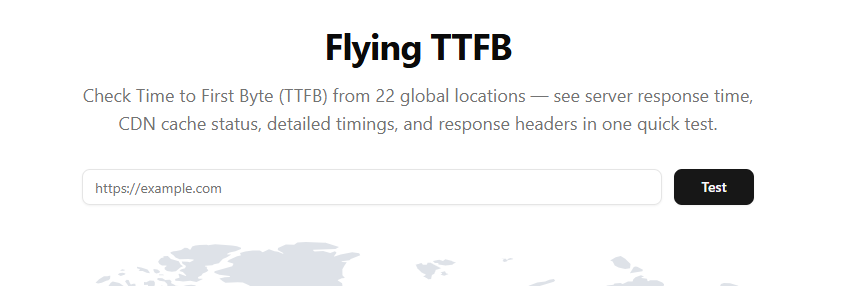
Flying TTFB is a new measurement tool released by FlyingPress (Gijo Varghese). It’s a little more advanced than KeyCDN, since you can check time to first byte from 22 global zones.
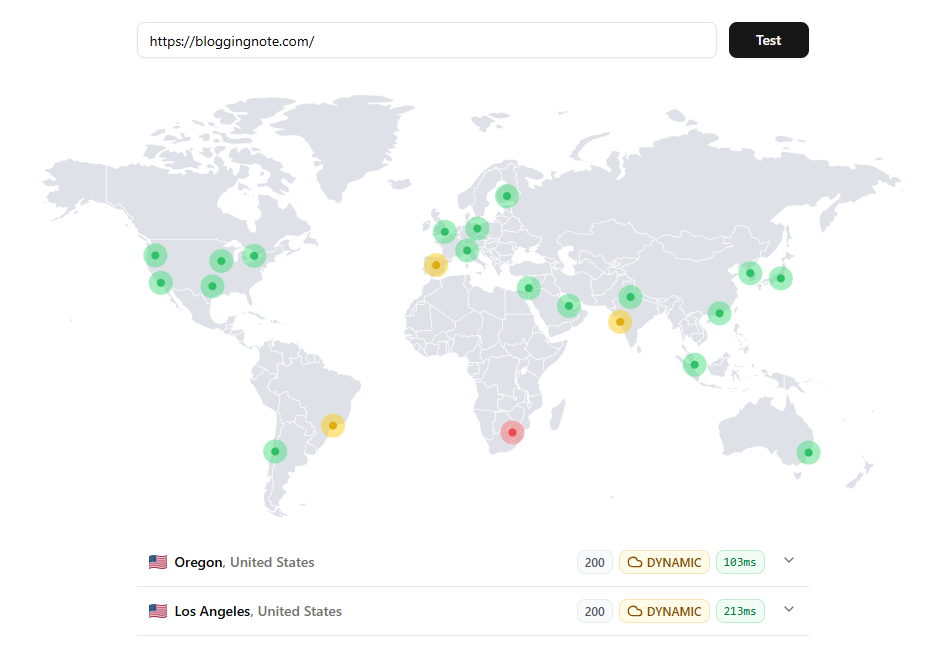
During one quick test, you’ll see server response times, cache status, and header information.
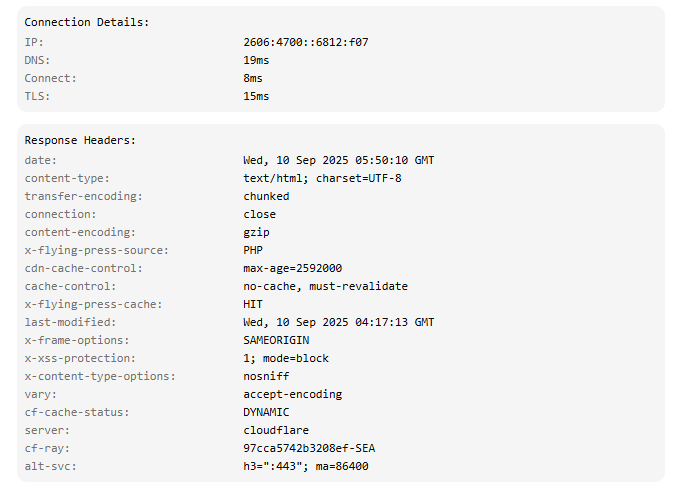
You can also view details such as IP address, encoding type (Brotli/Gzip), and cache source. It is a handy tool for checking your website’s time to first byte, with over 20 locations with HTTP header statistics. It is from the WordPress speed enthusiasts behind the FlyingPress optimization plugin, FlyingCDN, and other Flying plugins.
SpeedVitals
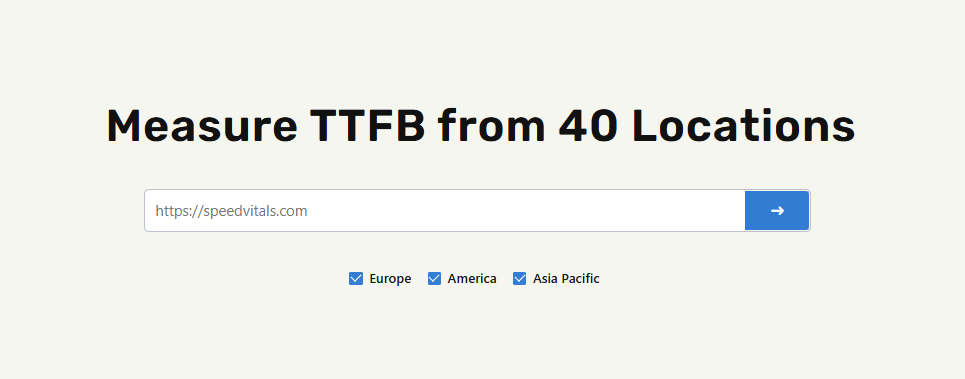
SpeedVitals is a comprehensive website performance test tool, making it more suitable for testing multiple locations and details than the previous two options.
It is an ideal alternative to GTmetrix or Pagespeed Insights because you can test multiple URLs and website speed from 40 different countries.
You can use most of their tools for free, but if you wish to use them at the top level, you must subscribe to their paid plans.
Users can use SpeedVital’s TTFB Testing tool for free across 30 locations. To access all zones, you have to pay. Another benefit is that you can test the time to first byte separately for Europe, America, and the Asia Pacific. It is top-notch.
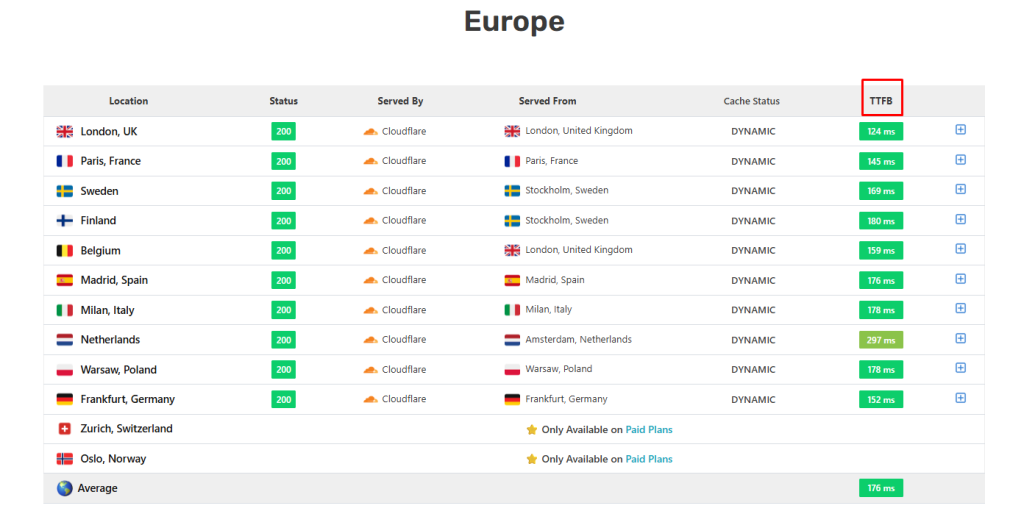
At the end of the results, you can see the measured TTFB separately for Europe, the Americas, and the Asia Pacific.
Additionally, you’ll see the HTTP header for every location, along with a summary of all locations that includes the average time to the first byte of your site.

So, SpeedVitals isn’t just a measurement tool; it’s a comprehensive package for those who care about website speed performance and other key considerations related to website optimization. It’s one of my favorites as a WordPress speed enthusiast.
GTMetrix

GTmetrix is one of the most popular tools for testing and monitoring webpage performance. Yes, it is an all-around tool for measuring pages at various levels.
GTmetrix was a free tool with plenty of features, but now you must create a free account to use it effectively, and it is limited to five tests on demand.
To test your web pages globally, you’ll need a paid plan. Still, the free account lets you test web pages in 10 different areas, and the paid account allows you to test web pages in 25 different locations worldwide. When using GTmetrix to examine your first byte time, simply test the URL, and you will be able to see it in the results.
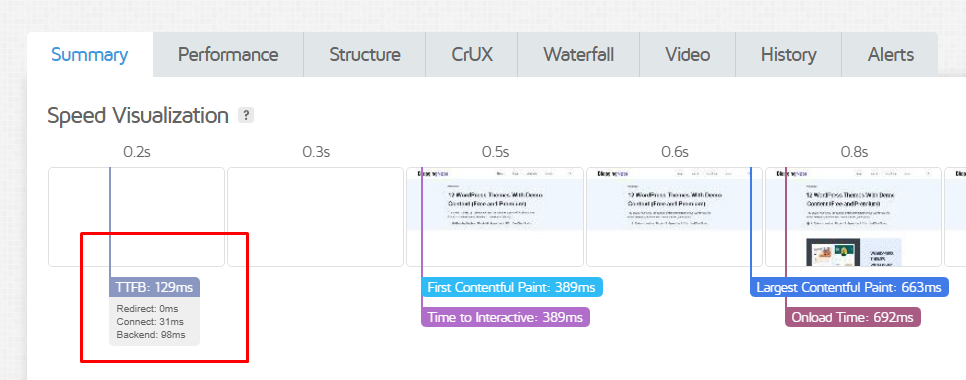
GTmetrix results provide a comprehensive overview of performance information about your website. On a page, you can view the total loading time arranged by the type of site asset. I like the Waterfall Chart because it helps us identify what’s causing the website to slow down. It’s still a valuable tool for web owners/devs.
WebPageTest
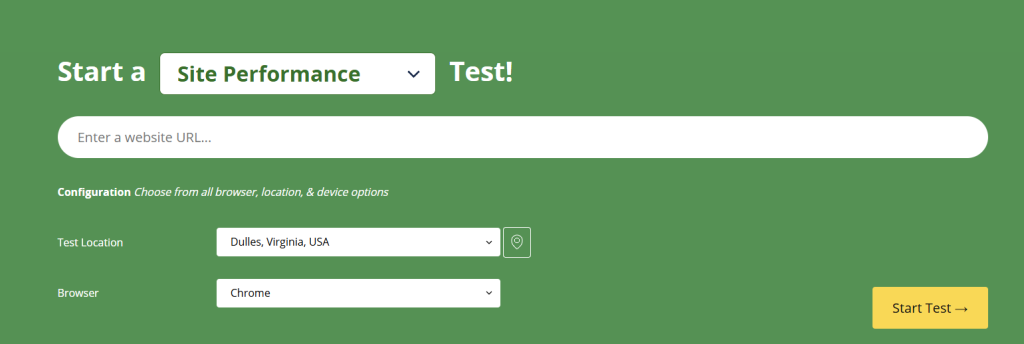
WebPageTest provides an in-depth look at your website’s performance. Even the free account allows you to analyze data from over 20 locations.
Yes, it’s an advanced tool for anyone seeking configuration options for browsers, locations, and devices. You can also set the connection speed and the browser dimensions.

Put simply, when you test your URL, its performance overview provides a detailed breakdown. It’s not just about the first byte; you can see the optimization summary for each asset on the website. Additionally, you can view the technologies used to create your website, such as WordPress, PHP, themes, plugins, and CDN.
Yes, WebPageTest is one of the most comprehensive tools available to measure webpages. There are more details about your site than just performance stats.
PageSpeed Insights

PageSpeed Insights is a widely known website performance diagnosis tool to analyze how well a site performs, which is also referred to by its initials, PSI.
It is an entirely free tool provided by Google for developers. It is a comprehensive tool for analyzing websites separately on desktop and mobile devices.
Compared to GTmetrix and WebPageTest, it’s not as complicated, but still, you can identify a lot about your site. Users can check your Core Web Vitals Assessment for both desktops and mobile devices.
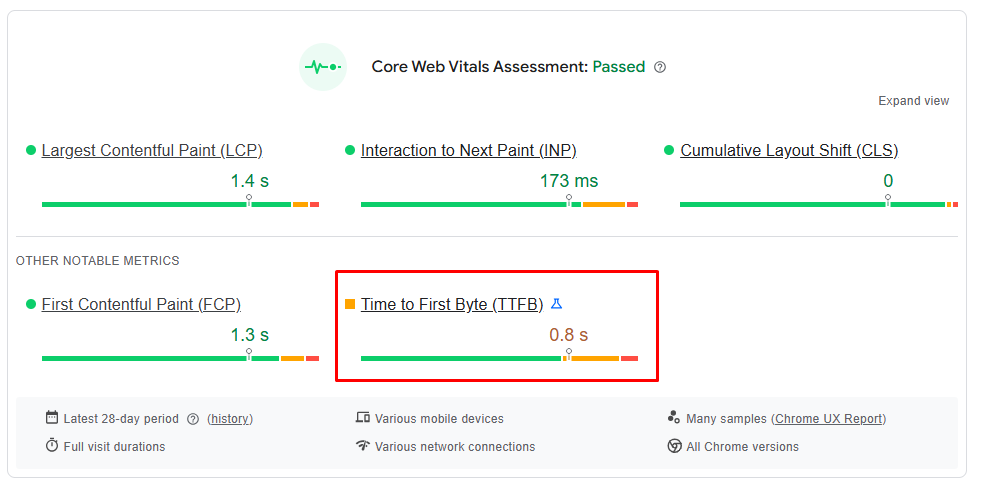
PSI gives you an idea of your website’s performance, TTFB to real browsers.
So those are the measurement tools that check the time to the first byte of your website. They’re usually comprehensive, not just statistical ones.
Now let’s talk about optimization.
Optimize TTFB With These Tactics
- Web Hosting: When your hosting is poor, it does not matter what kind of optimization techniques you implement. A good host is the first step to optimizing TTFB. Typically, a decent VPS can handle most types of websites, so consider Vultr, UpCloud, DigitalOcean, or any other reputable VPS provider. Or you can use a modern host like Rocket.net, Servebolt, Rapyd.cloud, etc.
- Modernize Your Server Applications: Keep Your Server Applications Up to Date. Ensure you’re running the latest versions of PHP, Redis, LiteSpeed/Nginx, MariaDB, and other necessary features.
- CDN: A CDN helps websites handle global traffic, ensuring better performance for distant users. However, it’s not always accurate, as even with a CDN, you likely wouldn’t notice any improvement. This is because you’re using it without any optimization features. Many CDN services, such as Cloudflare, BunnyCDN, Fastly, and others, offer tools to accelerate webpages for global users.
- Cloudflare: IMO, Cloudflare is the most reliable CDN and security solution. Cloudflare makes it easy to optimize TTFB with APO and Argo Smart Routing, which can reduce the first byte latency to less than 100ms on average.
- Edge caching (Dynamic): Dynamic caching is usually included by default with modern CDNs. Caching HTML can cut TTFB in half. When you use a reliable CDN with dynamic caching, you can achieve a TTFB of under 200ms.
- Caching: Most CMSs and web servers offer different cache versions. You can significantly optimize your website using cache plugins like FlyingPress, LiteSpeed Cache, or WP Rocket for CMS platforms like WordPress. Modern hosting services utilize server-side caching mechanisms.
You can test your webpage’s time to first byte with the KeyCDN Performance Test, Flying TTFB, and SpeedVitals. Additionally, aim to keep your website’s average global response time under 400 milliseconds. Additionally, users can utilize other tools, such as GTmetrix or WebPageTest, for more in-depth analysis.
Read more: Methods To Copy Text From Protected Website | Webdock

